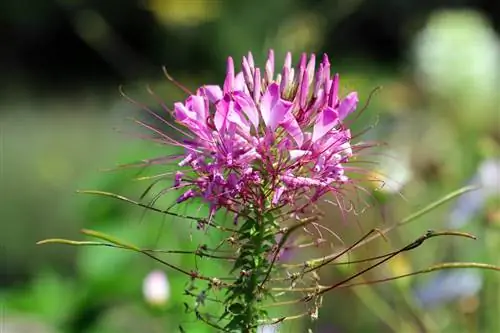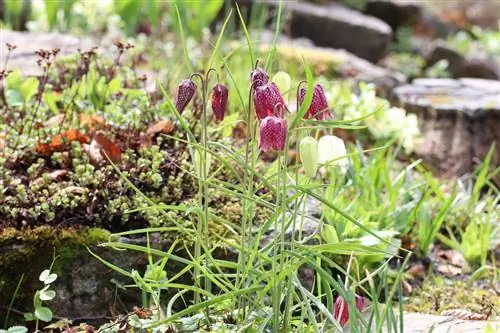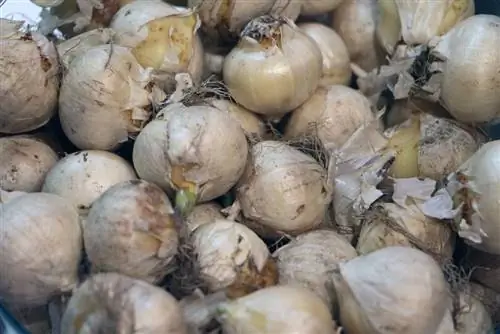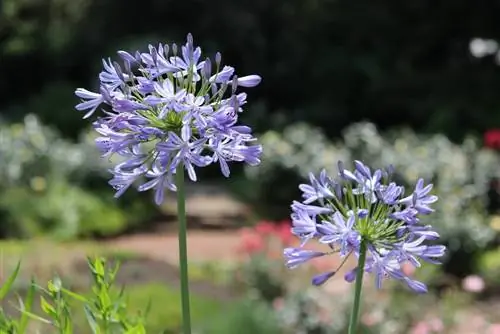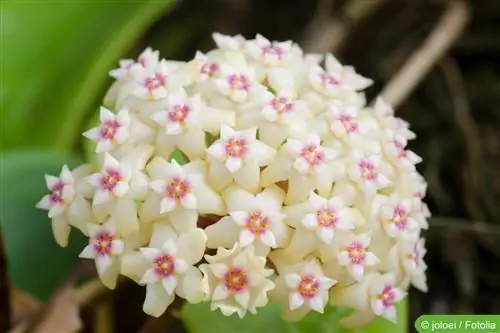- Author admin [email protected].
- Public 2023-12-17 03:39.
- Last modified 2025-06-01 06:48.
From late summer onwards, the spider flower conjures up a delicate lightness in the flower bed. The spider plant is cultivated as an annual and you can propagate it yourself by sowing. It is not hardy and is usually not overwintered because it is easy to propagate.
Profile
- Botanical name: Cleome hassleriana (most common species)
- Family: Cleomaceae
- Flower colors: violet, pink
- Flowering time: July - October
- Growth height: 80 - 100 cm
- Origin: South America (mainly Bolivia, Brazil, Argentina, Paraguay)
- toxic to humans and animals
- around 300 different species
- popular varieties: SENORITA ROSALITA, FESCHE FANNY
- Inflorescences with thorns
Location
Spider flowers prefer a spot in full sun that is protected from wind. It can also be grown in partial shade, but this is at the expense of flowering. Spider plants fit very well into the perennial bed, but due to their size they should be in the back rows.
The following plants are suitable as direct neighbors in the perennial bed:
- Knightspores
- Marigolds
- Torch Lilies
- Jewelry basket
- Grasses
The spider flower can also be cultivated in a pot or bucket. It should then also be placed on a balcony or terrace, protected from the wind and in full sun.
Substrate
The spider plant likes nutrient-rich soil, but it must be permeable. You can mix garden soil with compost or horn shavings to give the plants a good foundation. If you have a garden soil that tends to become waterlogged, work sand into the soil as drainage.
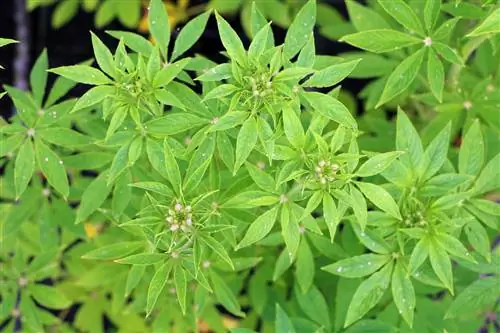
Note:
When growing in a container, normal potting soil is sufficient. It no longer needs to be enhanced with additional fertilizer.
Sowing
Spider flowers are light germinators. You can grow the plants or scatter the seeds directly into the bed. The spider flower will bloom much earlier if you prefer it protected. Start sowing in March at the latest.
Sowing instructions:
- Fill the seed tray with seed soil
- Moisten the soil
- Distribute seeds evenly
- Press seeds lightly
Moistening the soil beforehand will prevent the seeds from being covered by soil that becomes soggy. Cover the seeds with a transparent cap. This will prevent the soil from drying out quickly. The seeds must remain constantly moist during germination.
Note:
When sowing, temperatures should be at least 18 - 20°C. Place the seed tray on a south-facing window so that the seeds have enough light.
Pricking
The spider flower germinates very quickly. After a few days the cotyledons will already appear. As soon as the young plants have reached a height of six to eight centimeters, you can separate them. This promotes root formation and strong plants grow.
Use a mixture of seed and potting soil as the substrate. The substrate should be richer in nutrients, but not too rich. This stimulates the formation of roots.
Planting out
The spider plant is not hardy. The early plants can therefore be put outdoors at the earliest in mid-May, when there is no longer any danger of frost. The spider flowers are usually planted in groups, which makes them more visually attractive. However, here too, ensure a planting distance of at least 40 cm. This prevents the plants from having to compete for light and nutrients.
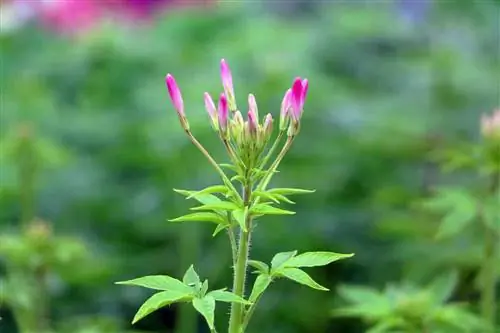
In the initial period after planting, make sure that the plants are supplied with sufficient water. Once the spider flowers are rooted, you can slightly reduce the amount of watering.
Tip:
Give the spider flowers a plant stick. They break off easily and heavy rain can kill the plants.
Pouring
The spider plant tolerates short dry periods well. However, this should remain the exception, because in order for the plants to develop well, they should be regularly supplied with water. Avoid soil that is too wet and always water moderately.
The plants need an adequate supply of water, especially in the hot summer months. Always water close to the ground and avoid getting leaves and flowers wet. Regardless of whether you cultivate the spider flower in a bed outdoors or in a pot, make sure that it does not become waterlogged.
Fertilization
Spider flowers need a regular supply of nutrients. In addition to basic fertilization before planting, you should add liquid fertilizer to the irrigation water. Water with liquid fertilizer every two to three weeks. Fertilization is maintained constantly until autumn, until the plants have died due to frost.
Commercial fertilizer is suitable as a liquid fertilizer for flowering plants. You can also use home-made nettle manure for fertilization. It also has the advantage that you can prevent pests to which the spider plant is susceptible.
Make nettle manure:
- Roughly chop the herb
- Fill the bucket 2/3 full with cabbage
- fill with water
- stir regularly
As soon as the herb has largely decomposed, you can add the manure to the irrigation water in a ratio of 1:10.
Seeds
Spider flowers are rarely available commercially as pre-grown plants, but only as seeds. Once you have spider flowers in your garden, you can collect seeds yourself. You can collect the ripe pods from around August. You can also simply leave the seeds out; they can overwinter outdoors compared to the plants. The seeds germinate in the bed if the temperature is consistently above 18°C.
pruning
Spider plants do not need pruning. However, it is beneficial if you regularly remove wilted leaves and dead inflorescences. Even if you want to get seeds, limit it to a few flowers that you allow to mature. This ensures that the spider flowers continue to bloom.
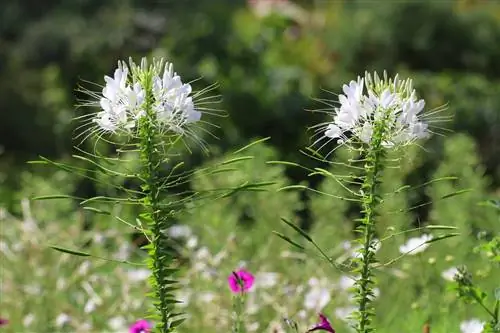
Wintering
It is not necessary to overwinter the spider plant. Attempts to overwinter them usually fail because the plants don't get enough light. The effort required to overwinter them is also disproportionately high, which is why it makes more sense to collect seeds until autumn and use them again for sowing.
Diseases
A disease that results from a care error isRoot rot The roots die due to too much moisture, which prevents the plants from absorbing water and nutrients. As a result, the entire plant dies. Plants in pots are particularly affected. You can easily prevent root rot by watering moderately. If water accumulates in the coaster, pour it out.
Pests
Occasionallyaphids settle on the spider plants. You can prevent infestation by fertilizing with nettle manure. In this case, you can also shower the plants so that the aphids are washed off. Encouraging predators also helps in the fight against aphids.
Spider plants have a natural defensive substance due to their toxic ingredients, which means that aphids are rather rare. This also applies tosnails,which rarely eat the plants. They only turn to the spider plant when food is scarce.
Black weevils can become a problem. They eat both the leaves and the roots. Larvae on the roots in particular usually mean the death of the plants. To prevent this from happening, check regularly for damage to the leaves. If you find indentations there, check the roots. If larvae have settled there, you can fight them with nematodes that you add to the irrigation water.
Usage
The spider flowers are ideal for creating beds in very sunny places. They thrive in locations where other plants have problems due to dryness and heat. The spider plant is suitable as agroup plant,but it also cuts a fine figure as asolitary perennial in a pot or as a border, for example on driveways.

Spider flowers are also ideal as annualunderplanting in summer. It can provide shade on the ground for many plants, such as roses, thereby preventing other plants from suffering from the heat. In addition, it is not particularly attractive to most pests, which means it can also be used to repel pests.
Due to the fact that it is not hardy, it hardly requires any work after the first frost. The leftovers are simply disposed of in the compost and your beds are cleared.
The spider flower is only suitable to a limited extent as acut flower. It should be placed in the water immediately after cutting, otherwise it will wilt. It does not get along with other plants in the vase due to the toxic ingredients.

